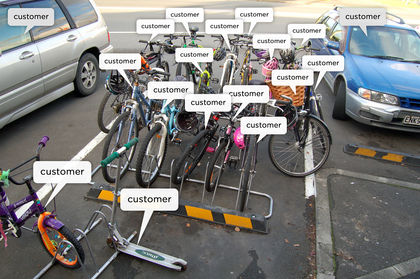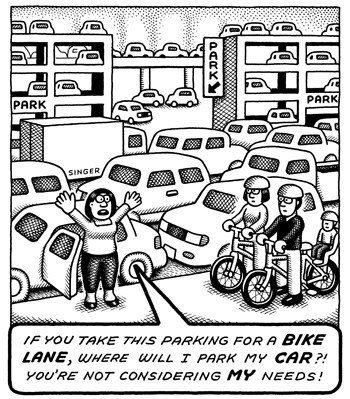If you ride a bicycle in traffic, you've probably had the experience of returning to the road after a couple of weeks away and thinking "what the hell is this?" The reality of sharing the road with flying two-ton chunks of metal can bite pretty hard until you get back into the groove.
A friend of mine who works in the media precinct around Victoria Street West experienced a different form of road shock recently when the Lightpath closed for a few days to have a fresh, and hopefully more durable, pink surface applied.
She'd grown used to the charmed experience of riding between Western Springs and work almost entirely separated from traffic; via the SH16 shared path, the Lightpath and the Nelson Street cycleway. But with the Lightpath briefly closed, she found herself going over the Hopetoun Street bridge, where there isn't even a lane, and then fighting for a position to turn right from Ponsonby Road.
She really didn't like it: it made her anxious and somewhat reluctant about what she'd been happily doing most days – riding to work. In truth, the SH16 path's connection to the CBD is a pain in the arse (bring on the Ian McKinnon Drive Cycleway!) but for most people it's better than tangling with rush-hour traffic.
I do sometimes dwell on what we're asking people to do when we evangelise cycle-commuting. I understand how it looks like a bloody hard ask.
And yet, in the Herald, Jamie Morton reports on a new study by University of Auckland researchers (it's here at the Journal of Transport and Health if you have institutional access, which I don't) which finds that riding regularly carries a far lower risk of injury than is commonly supposed. It assessed the risk of injury of cycling three times a week to be 140 times less than skiing four or five times a year and 530 times less than playing rugby once every three weeks. It's about as dangerous as carrying out home DIY twice a month.
The measure of injury is worth noting here: the study counted ACC claims for injury from each activity. It would be fair to say that that prospect of being hit by a car on your bike (or even just falling off) is scarier than that of turning an ankle on the rugby field or wrenching a knee on the piste. The stakes are pretty high, and that's a strong disincentive in itself, even if the chance of injury (about nine times in every 100,000 short urban bike trips) is quite low.
It's also a fact that not getting injured is a fairly demanding, even stressful business. As study co-author Professor Alastair Woodward notes to Morton:
"If I ride into town along Remuera Rd, it's a real headache having to watch out for people opening their doors or not seeing you," he said.
"Because I've done it so often, I know the chances of getting actually knocked off my bike are pretty small but it's a pain in the neck that you have to watch out."
And you always have to watch out. Ironically, I think the level of attention required to cycle in traffic often functions as stress relief for me – I don't have time to dwell on whatever thing I might have been dwelling on at my desk because I'm busy not getting killed (my attention to not getting killed has undoubtedly been heightened by being involved in two not-my-fault car accidents in the past six months – I basically trust no bugger). But I can hardly ask a new cyclist to jump on a bike and feel the same way.
Professor Woodward notes that what we're seeing is the consequence of the marginalisation of cycling as transport. We're scrapping for space because in most cases no space is provided for us:
"The bicycle has been pushed to the margins, where it is seen as unusual, different, not mainstream, and unfamiliar."
In the past, a hostile environment on New Zealand roads had led to a "vicious spiral". There had been fewer bikes, leading to greater fearfulness and increased resistance to road changes in favour of bikes.
"We need to turn this round. The most powerful way to bring bikes back from the margin is to provide safe spaces for cyclists of all abilities to get to where they want to ride."
Separated cycle ways are part of the fix, he said, but not enough.
There needed to be changes on the road as well, such as slower vehicle speeds, better intersections, and wider shoulders to include the bicycle.
"More people riding, and public spaces that celebrate two-wheeled choices, will do two things: make cycling even safer, and reduce the fear of the bike."
Most of these are public infrastructure solutions, and rightly so. But slower vehicle speeds aren't necessarily mandated. They can be the choice of drivers. I think I've become a better driver though being a cyclist: I cringe when some arsehole roars past me on a Point Chev side-street, because it tightens the margin for error on both our parts.
Anyway, as I've noted here before, taking up an e-bike – thus becoming more of a vehicle – has rekindled my affection for dedicated paths. I'd like my lane, please.
For all the blatherings of windbags on the radio, this change is going on in Auckland. The city is transforming and it's happening more quickly for those of us who already live adjacent to established parts of the cycling network. But the rate of progress isn't a given, and Bike Auckland has a useful explainer as to what the implications of local budget priorities are for cycling. (Submissions close at the end of the month.)
Cycling is much safer than people think. But until things change, fear of cycling will keep many reasonable people off the roads.
–––
PS: 32% of trips in central London are now by bike. They built it and people came.
Build it and they will come.
— 21st Century City (@urbanthoughts11) March 12, 2017
32% of trips in central London are now by bike, acc to London Authorities
RT @steinskypic.twitter.com/PoLtoK3A0N

